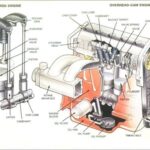Classic car ownership brings a unique set of challenges, especially when it comes to maintenance and sourcing reliable parts. For those passionate about preserving authenticity and ensuring optimal performance, original components are often preferred over modern reproductions. This holds particularly true for critical brake system parts like wheel cylinders. When faced with the dilemma of corroded or pitted cylinders, sleeving emerges as a superior solution, maintaining originality while enhancing durability.
Wheel cylinders, integral to the hydraulic brake system, are prone to internal corrosion and pitting over time, leading to leaks and compromised braking performance. As highlighted in a recent repair experience, even cylinders rebuilt with standard kits can fail prematurely if the underlying bore is not properly addressed. In such cases, simply replacing with readily available reproduction cylinders might seem convenient. However, for enthusiasts dedicated to their vehicle’s heritage and long-term reliability, sleeving original cylinders offers a compelling alternative.
The process of sleeving involves inserting a new, precision-machined sleeve into the cylinder bore, effectively creating a fresh, smooth surface for the piston and seals to operate against. This not only eliminates the issues caused by corrosion and pitting but also often results in a more durable component than many reproduction options. A key decision in sleeving is the material of the sleeve itself. While brass has been used, stainless steel is increasingly favored for its superior corrosion resistance and longevity. Furthermore, opting for sleeves machined from solid bar stock, rather than tubing, ensures greater robustness and dimensional accuracy.
Finding a specialist skilled in sleeving classic car components is crucial. Mark Frappier in Massachusetts is one such expert who comes highly recommended. Utilizing 303 stainless steel bar stock and offering a quick turnaround, services like his provide a valuable resource for classic car restorers. The process typically involves sending in the cylinder for machining and then reassembling it with a standard rebuild kit, readily available from suppliers like Rock Auto. This approach allows owners to retain the originality of their brake system while ensuring reliable performance for years to come.
The growing trend of skilled machinists retiring poses a challenge for the classic car community. Services like wheel cylinder sleeving, essential for preserving these vehicles, are becoming increasingly scarce. Proactive maintenance, such as sleeving all wheel cylinders before issues arise, becomes a prudent strategy. Spotting a small brake fluid leak serves as a timely reminder of the potential for hidden corrosion within these critical components. For classic car owners seeking to maintain the integrity and performance of their vehicles, investing in the sleeving of original wheel cylinders is a worthwhile endeavor, ensuring safety and preserving automotive history. And for sourcing other essential, high-quality parts for your classic car projects, exploring reputable suppliers specializing in classic components is always recommended to complement such meticulous restoration work.
